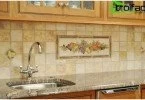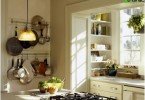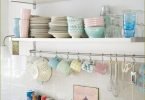What tiles to choose for the kitchen
Everyone who started a repair in the kitchen will have a lot of trouble with the selection of a suitable option for the design of the room and with the implementation of the plan. The issue of choosing materials for decoration is no less important than the design project. As the main material for wall decoration, you can use washing wallpaper, and lining, and even wood. But is such a choice functional for the kitchen? For many years now, ceramic tile has been considered the most practical option. Because of resistance to aggressive influences, environmental friendliness and always faultless appearance. There are a great many variants of tile performance: it is different not only in color, texture and size, there are a lot of differences in operational characteristics. To decide which tile is best for the kitchen, consider in more detail all aspects of the choice.
Content
- Benchmark – Performance
- Wear resistance is the interest of conservatives
- Tile surface hardness
- Temperature Resistance
- Moisture absorbing ability
- Chemical aggression resistance
- Anti-slip on the floor
Benchmark – Performance
- Wear resistance.
- Surface hardness.
- Temperature Resistance.
- Water absorption.
- Chemically aggressive resistance.
- Slip resistance.
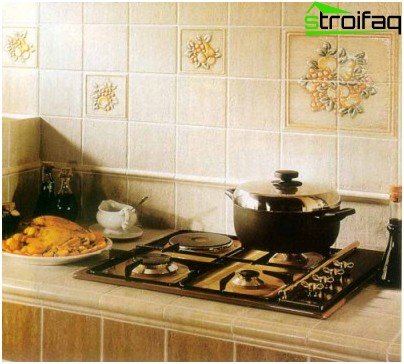
An example of the use of decorative elements in cladding
Wear resistance is the interest of conservatives
The service life of floor tiles largely depends on the suitability of the selected material for the expected loads..
Wear resistance or, in other words, the abrasion resistance of floor tiles intended for the kitchen belongs to group 3, as an indicator of the abrasion of tiles for rooms with an average traffic intensity. It is designated by the symbol PEI III.
Tile surface hardness
The hardness of the surface of the tile (determined by the MOOCA scale) is an indicator that determines the ability of a material to withstand scratches from exposure to various abrasive materials. A number from 1 to 10 in increasing order indicates scratch resistance. For a kitchen tile an indicator of 5 is enough.
Temperature Resistance
Resistance to temperature extremes at first glance is not such an important indicator in the kitchen. But if it is supposed to be tiled with a surface onto which a hot kettle can be inadvertently put, then it is better to choose a tile with the corresponding indicators (at least 125? C).
Moisture absorbing ability
Moisture absorption and frost resistance depend on the porosity of the material. These indicators are relevant if it is intended to finish the surface in an unheated room..
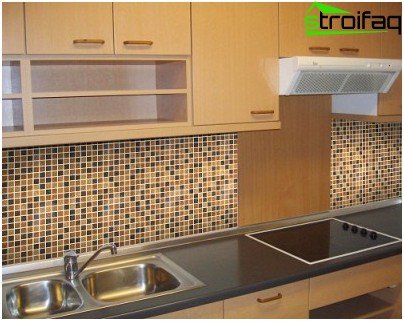
Mosaic wall option
Chemical aggression resistance
This indicator determines the degree of surface resistance of various household chemicals, as well as resistance to staining. The ability of a surface to resist staining is evaluated from a larger indicator (1) to a smaller one (3), for the kitchen the optimal value is 1 or 2. The indicator of resistance to chemicals AA means that the product is not exposed to chemicals, indicator A means that the product is resistant to aggressive the impact.
Anti-slip on the floor
That the tile must be safe is beyond doubt. When choosing floor tiles, the basic safety requirement is slip resistance. This indicator displays the coefficient of friction. Most often it is measured according to DIN standards. For kitchen flooring, the corresponding indicator is R10, category A.
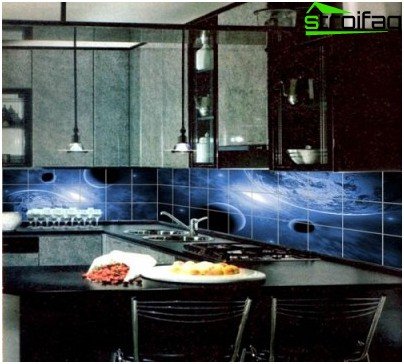
Variant of apron facing
Which tile is better for the kitchen
If only part of the wall is supposed to be tiled: the work surface above the sink, part of the wall near the hob and above the countertop (the so-called “apron”), then it is more advisable to choose small-sized tiles of the correct shape. Perhaps the addition of a decorative frieze or the insertion of decorative elements between even rows of tiles. The main thing is the coincidence of the size of the decor and the main tile, in the case of even a slight, it would seem, a difference of several millimeters, the geometric alternation of elements will inevitably reveal a flaw. The seams will be of different sizes, which in turn will not decorate the general appearance of the lined surface. A few words about grouting for joints. You can choose a grout color to match the shade of the tile, or use a grout of a contrasting color (repeating the color of the flooring, or the color of the furniture). In any case, the use of a special plastic material for grouting joints will protect the tile coating from the development of mold and fungi, as well as from the possible lag of the tile from the wall.
How to choose: tips
It is more difficult to wash a relief surface from drops of fat, than smooth. Therefore, when choosing wall tiles, it is better to pay attention to tiles with a smooth surface. But when choosing a floor tile, it is better to pay attention to the matte surface or slightly embossed, on the smooth floor small scratches will be noticeable.
Use caution when buying tiles with a margin. About 10% of the total volume of tiles will be useful to you for several reasons: firstly, in case of unforeseen troubles during installation, you protect yourself from the need to look for missing tiles in stores. Secondly, in this way, you take into account the possibility of restoration of the surface in the future. It is important to consider that you can easily “not get into color” when buying tiles of the same collection, but of a different batch.
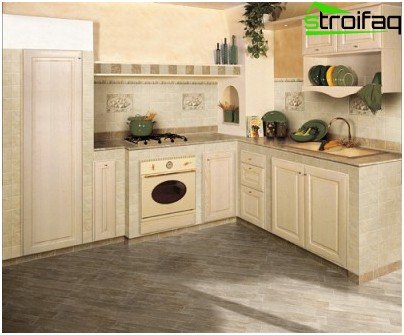
The unity of style of wall and floor tiles
When choosing a finish color, each is guided by personal preferences, but it often happens that the tile in the store seemed spectacular, but for some reason it doesn’t look at home. The fact is that when choosing the color, texture and pattern of tiles, several factors should be taken into account: illumination, room size, general stylistic direction in the interior. When choosing floor and wall tiles, it is important to consider the compatibility of colors and textures. On sale there are also ready-made collections of tiles, in which a combination of colors of decorative elements, wall and floor tiles is already selected. It is only necessary to make accurate measurements of the kitchen and calculate the required number of tiles of each type.
When choosing a facing tile, pay attention not only to its color, but also to the quality – evenness of the corners, the integrity of the edges, the quality of enamel and so on. This is best done with a specialist who will lay this tile, because in any business there are a lot of subtleties that the average consumer does not even know about. Of course, a perfectly flat tile does not happen, but still. One of the indicators of tile quality is the reputation of its manufacturer, you should not be tempted by cheapness – you risk buying a pig in a poke, and you should not chase very expensive brands – overpay for popularity. Here’s a tip – always choose a middle ground.
As you can see, the issue of choosing tiles for the kitchen is easily solved. It is enough to show interest and arm yourself with relevant information on the topic.


